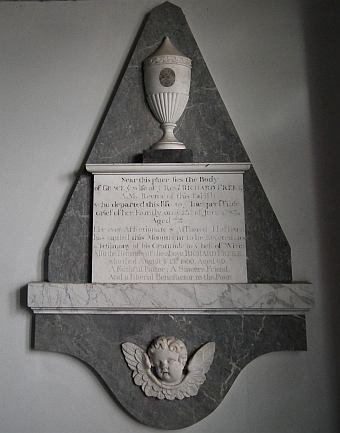The Freke Family and Dr John Mortimer
For 75 years the Freke family supplied the parsons to the comfortable living of Clannaborough.
Rev John Freke was born in 1699, one of the twelve children of Rev Francis Freke, Vicar of Loddiswell. Formerly Chaplain to the Bishop of Norwich, he was appointed Vicar of Clannaborough in 1733.
On his death in 1754 he was succeeded by his brother, Rev Richard Freke, who, while he was Vicar of Clannaborough, was also Curate of nearby Down St Mary and Rector of Beaford. As a curate in Thorverton in 1740 he had married Grace Thomas. He died aged 90 in 1800.
There is a memorial to the couple in Clannaborough Church


In 1783 his son Rev Freeman Freke (1742-1809) took over as vicar. (His son Thomas (1774-1837) was Rector of both Loddiswell and Down St Mary, and married Maria Wreford of Natson, Bow, whose sister was married to Samuel Budd, surgeon of North Tawton). Rev. Freeman Freke had an unusual way with words, describing some of the unmarried mothers of children he baptised as "an harlot".
In Clannaborough in 1806 Freeman Freke’s daughter Elizabeth then aged 39 married John Mortimer, a 24 year old naval surgeon born in Torrington in North Devon. (His father, also a surgeon called John, had been buried at Clannaborough in 1793 and had presumably been living nearby.)
John Mortimer junior’s naval career started in 1805 when he was an assistant surgeon on board HMS Africa at the Battle of Trafalgar. He then served in the Caribbean for nine years: He first ran the hospital in the islands of Antigua and Martinique, at that time in British hands. In 1809 he was appointed Principal Naval Medical Officer to the Hospital in Barbados for over six years.
Between 1816 and 1817 he served as surgeon on the convict ship “Fame” on a voyage to Australia and back.
Back in Torrington in 1820, he described the successful treatment of a child who had eaten rat poison containing a mercury salt. This involved the child, who was under two, swallowing the whites of 67 eggs.
Whilst serving in the West Indies he cared for patients suffering from Yellow Fever. At that time it wasn't known that the disease was spread by mosquito bites, and there was a debate as to whether the disease was contagious. He wrote a report, correctly stating:
“We do not allow the fever of the West Indies, commonly called the “Yellow Fever” to be at all infectious in any of its forms or stages.
We have never known of an instance of its communication to patients at the several naval hospitals, whilst under cure for other complaints, though such patients have never been interdicted, on the contrary encouraged, to offer every additional aid, for the greater comfort of their suffering brethren.
We are of opinion … that vapours emitted from holds of ships having in them the commixture of various animal and vegetable substances, in a state of putrefaction, are quite sufficient for the production of the worst kind of Bulam [yellow] fevers; that to such effluvia may be justly attributed much of the depopulation occurring among Europeans in intertropical climates.
He returned to the Naval Hospital in Haslar in 1830.
Then in 1833, at Bow Street Court in London, an Eliza Sparrow nee Stoddart "aged about 30" was charged with bigamously marrying John Shephard, a butcher of Gravel Lane, Southwark, whilst her husband Joseph Sparrow was still alive. Born in Barbados, Eliza claimed to be an illegitimate daughter of "Dr Mortimer, of Haslar Hospital, Portsmouth".
(Eliza had a son, born in Middlesex in 1825, named Joseph Mortimer Sparrow who, like his father Joseph, became a cloth worker employing several men. The parents separated when he was about a year old, and Eliza and her son spent some time in the workhouse.)
Eliza was found guilty and sentenced to be transported to New South Wales for seven years. She arrived on the "Buffalo" in October 1833. Little is known of her life as a convict other than that she ran away from her master in Sydney in April 1837, but was caught a few weeks later, after her description had been circulated:
"Sparrow Eliza , Buffalo , 33-545, 41, Barbadoes, nursery governess , 4 feet 9 ¾ inches , fair ruddy comp., auburn hair , hazel eyes, three scars inside left thumb, little finger of right hand crooked, genteel looking."
Back to Dr John Mortimer: In 1840 he was appointed Deputy to, then in 1846, as the Medical Inspector to the Royal Navy, based in Haslar. Elizabeth his wife died in 1847 without having any children, and he died in 1856.
by Peter Selley
